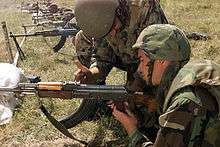Squad automatic weapon


A squad automatic weapon (SAW, also known as section automatic weapon or light support weapon) is a weapon used to give infantry squads or sections a portable source of automatic firepower. Weapons used in this role are often selective fire rifles, usually fitted with a bipod and heavier barrel to perform as light machine guns. Squad automatic weapons usually fire the same cartridge as the assault rifles or battle rifles carried by other members of the unit. This reduces logistical requirements by making it necessary to supply only one type of ammunition to a unit. Squad automatic weapons are light enough to be operated by one person, as opposed to heavy machine guns such as the M2 Browning, which fire more powerful cartridges but require a crew to operate at full effectiveness.
Overview
One of the first weapons used in this role was the Madsen machine gun. Although limited in today's terms, the Madsen was introduced in an era when the standard infantry rifle was a bolt-action repeater with fixed magazines reloaded with single rounds or chargers; sustained rapid fire with these weapons could be maintained only for very short periods of time. The Madsen was capable of automatic fire; despite having only limited magazine capacity, this was still more than that of the infantry rifle, and it was of the quick change detachable box magazine type. The standard machine guns of this era were of the Maxim type. Used by the British, Germans, and the Russians, these weapons were bulky, heavy, tripod-based, and water-cooled, they required a team of four men and, although excellent in the defence, were not suited to maneuver warfare.
Another pioneering weapon in this role was the Browning Automatic Rifle (BAR). Introduced late in World War I, it remained in front-line service into the Vietnam War. Intended originally as an automatic rifle capable of delivering suppressing "walking fire" in the advance, the BAR came to be used in the light machine gun role. During World War II, as the importance of having a source of mobile automatic fire increased, the number of BARs in a unit also increased, until in some units it represented 1 in 4 of the weapons present in a squad. During its long service in the US military, it was pivotal in the evolution of U.S. fireteam tactics and doctrine that continues to the present day.
Squad automatic weapons (such as the RPK and L86) are modified assault rifles or battle rifles (e.g. FN FAL 50.41 and M14A1) that may have increased ammunition capacity and heavier barrels to withstand continued fire and will almost always have a bipod. In the case of some assault rifles, such as the H&K G36 or Steyr AUG, the SAW is simply the standard rifle with a few parts replaced. However, the Austrian Army, though issuing the Steyr AUG rifle, does not issue the HBAR (heavy barrel) variant. Instead, the 7.62mm caliber MG74, a derivative of WW2-era German MG 42, is issued.
Light machine guns, either belt-fed or magazine-fed, may be used as squad automatic weapons, as may be general-purpose machine guns; for example, during most of the Cold War period, the standard squad automatic weapon in the British Army was the FN Mag-derived L-7. The most common squad automatic weapons in use today are derived from two basic patterns: the Kalashnikov-based RPK or the purpose-designed FN Minimi.
United States
In United States usage, the M249 light machine gun is commonly referred to as the Squad Automatic Weapon (SAW).[1][2]
The Infantry Automatic Rifle program was launched by the United States Marine Corps in 2005 to find a replacement for the heavy and cumbersome M249 SAW that was serving as the Squad Automatic weapon in a fireteam at the time. Two of the weapons in the competition were the FN SCAR HAMR and a slightly modified HK416. The weapon chosen to replace the M249 was the HK416, later designated the M27 IAR. The M249 SAW is still in use as a squad automatic weapon by the US Army.
Netherlands
The Netherlands Marine Corps is the only part of the Dutch military to use the LOAWNLD (an updated version of the Colt Canada Light Support Weapon) as their squad automatic weapon. All other branches use the FN Minimi for this role.
See also
References
- ↑ Boe, David (August 1, 1997). "Mission Continues" (PDF). The Talon. 3 (31). Eagle Base, Tuzla, Bosnia-Herzegovina: 1st Infantry Division (Task Force Eagle) Public Affairs Office. p. 6. Retrieved November 27, 2013.
Sitting atop the platoon leader's HMMWV, the 20-year-old soldier mans a Squad Assault Weapon and monitors traffic at the crossroads.
- ↑ Lewis, Jack (September 12, 2007). Ken Ramage, ed. The Gun Digest Book of Assault Weapons (7th ed.). Iola, Wisconsin: Gun Digest Books. pp. 14, 74, 156, 245. ISBN 978-1-4402-2652-6. Retrieved November 27, 2013.
When it comes to machine guns, FNH USA is turning out copies of the M249 Squad Assault Weapon (SAW) that has been in the US military inventory for several decades.